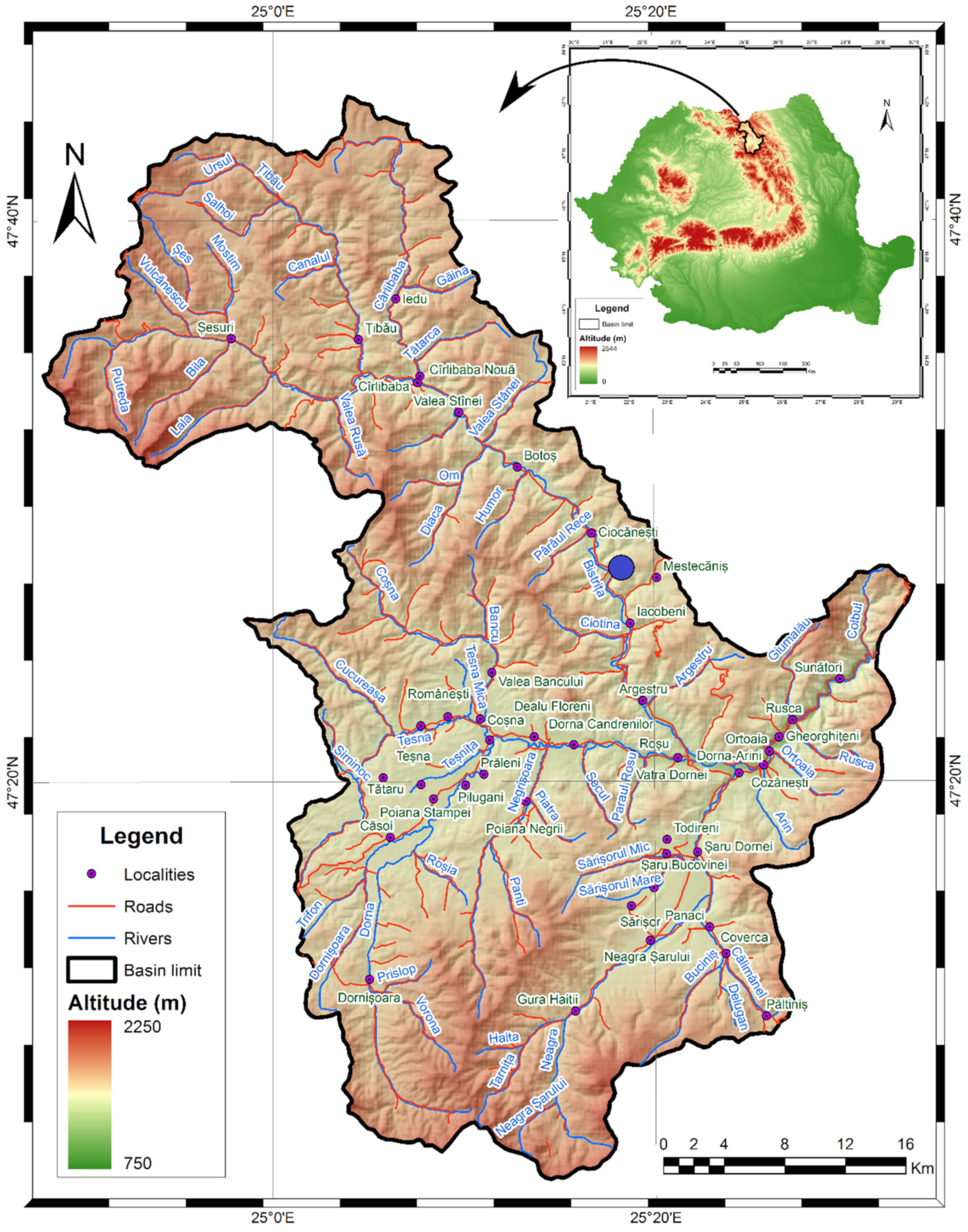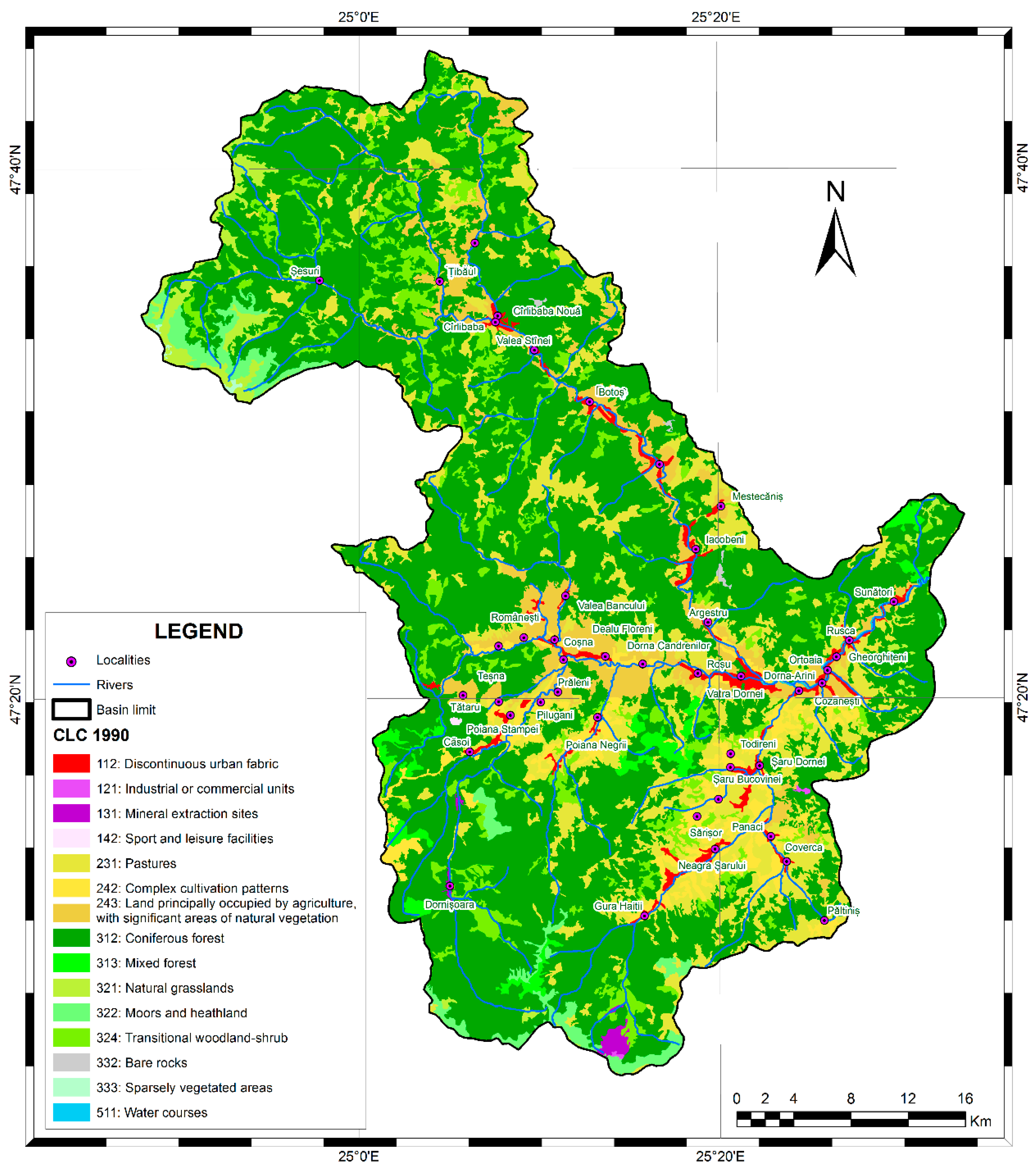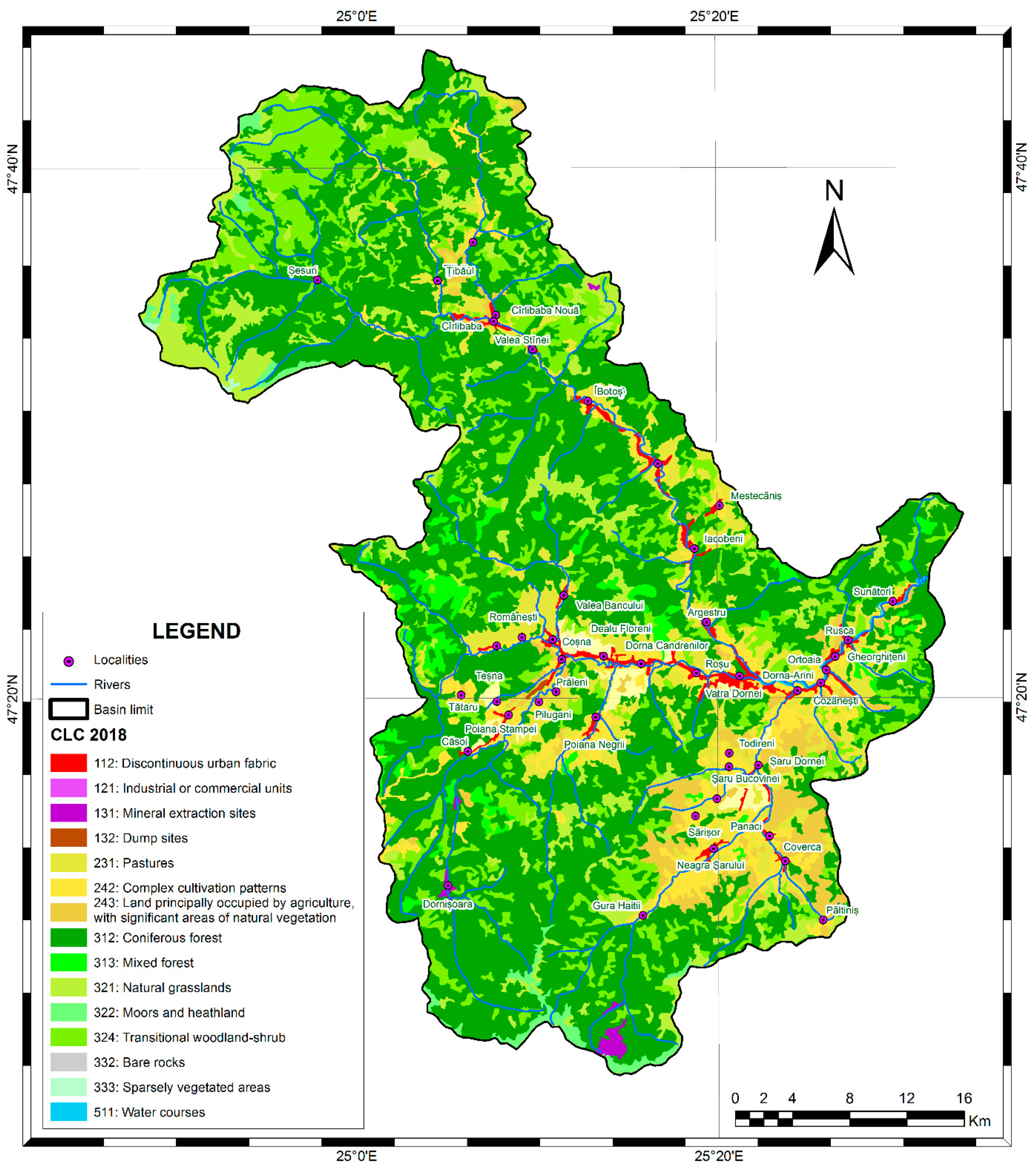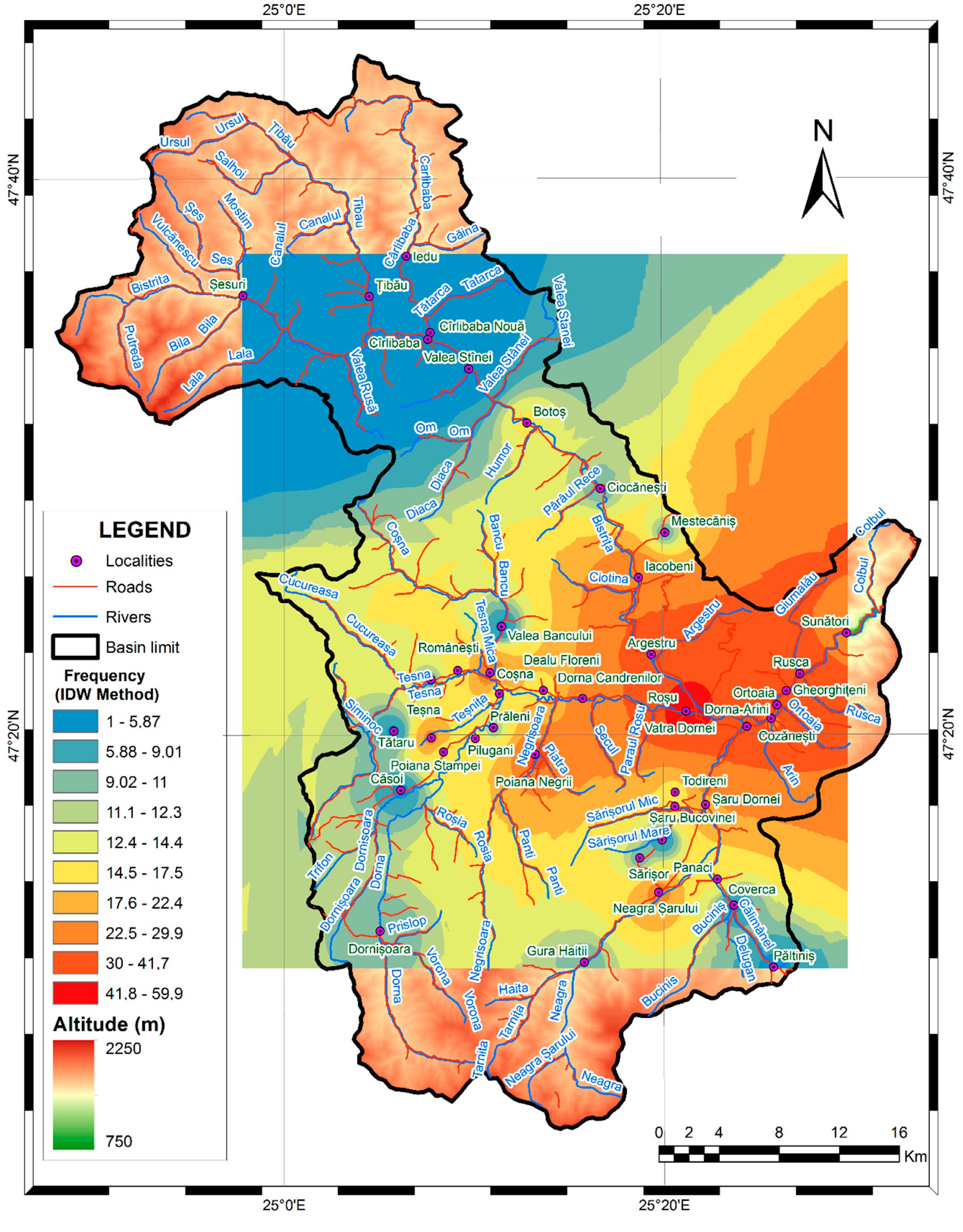Expansion of the Invasive Plant Species Reynoutria japonica Houtt in the Upper Bistrița Mountain River Basin with a Calculus on the Productive Potential of a Mountain Meadow
Abstract
:1. Introduction
2. Materials and Methods
2.1. CORINE Land Cover Assessment Method
2.2. Classical Phytocoenological Methods
2.3. Spectral UAV Scanning Methods
2.4. Inverse Distance Weighted (IDW) Interpolation Method
3. Results
3.1. Spectral UAV Scanning Results
3.2. Floristic Characterization and Evaluation of the Analyzed Meadow’s Productivity
3.3. CORINE Land Cover Analysis Results
3.4. Inverse Distance Weighted (IDW) Interpolation Results
4. Discussion
4.1. Habitat Degradation
4.2. The Calculation of the Impact
5. Conclusions
Supplementary Materials
Author Contributions
Funding
Institutional Review Board Statement
Informed Consent Statement
Data Availability Statement
Acknowledgments
Conflicts of Interest
References
- WFO. Reynoutria japonica Houtt. Available online: http://www.worldfloraonline.org/taxon/wfo-0000406106 (accessed on 21 May 2021).
- Jones, D.; Bruce, G.; Fowler, M.S.; Law-Cooper, R.; Graham, I.; Abel, A.; Street-Perrott, F.A.; Eastwood, D. Optimising physiochemical control of invasive Japanese knotweed. Biol. Invasions 2018, 20, 2091–2105. [Google Scholar] [CrossRef] [Green Version]
- Abgrall, C.; Forey, E.; Mignot, L.; Chauvat, M. Invasion by Fallopia japonica Alters Soil Food Webs through Secondary Metabolites. Soil Biol. Biochem. 2018, 127, 100–109. [Google Scholar] [CrossRef] [Green Version]
- Pricop, E.; Negrea, B.-M. Considerations concerning the distribution and impact of the most infamous invasive plant species from Bistrita River Basin (Neamt and Suceava Counties, Romania). AAB Bioflux 2018, 10, 40–56. [Google Scholar]
- Pricop, E.; Valeriu, S.L.; Negrea, B.-M. Review Regarding the Distribution and Impact of Non-Native Plant Species from Bistrița River Basin: A Comprehensive Species Inventory-In Print; Scientific Annals of Danube Delta Institute: Tulcea, Romania, 2021. [Google Scholar]
- Anastasiu, P.; Negrean, G. Allochthonous Plants from Romania, In: Scientific Annals of the “Alexandru Ioan Cuza” University of Iași. Plant Biol. 2005, 51, 87–96. [Google Scholar]
- Dihoru, G. Invasive plants in the flora of Romania. Ann. Univ. Craiova 2004, 9, 73–82. [Google Scholar]
- Doroftei, M.B. Chorology of Amorpha fruticosa in Danube Delta. Rom. J. Plant Biol. Rom. Acad. București 2009, 54, 61–67. [Google Scholar]
- Dumitrașcu, M.; Kuscicsa, G.; Doroftei, M.; Năstase, M.; Dragotă, C.S. Invasive terrestrial plant species in protected areas in Romania. Geogr. Approach 2014, 58, 145–160. [Google Scholar]
- Oprea, A. Critical List of Vascular Plants in Romania; University “Alexandru Ioan Cuza”: Iasi, Romania, 2005; p. 668. [Google Scholar]
- Sirbu, C.; Oprea, A. Non-native plant species from the Eastern Carpathians (Romania). J. Plant Dev. Iasi 2008, 15, 33–45. [Google Scholar]
- Pricop, E. Study of the Flora from the Middle Basin of Bistriţa (Neamț County) in order to Evaluate the Phytotherapy Utilities of Some Species, Univ. “Al.I.Cuza” Iasi, Faculty of Biology, Specialization Biodiversity and Ecosystem Productivity. Ph.D. Thesis, University “Al.I.Cuza” Iasi, Iasi, Romania, 2009. [Google Scholar]
- Sirbu, C.; Oprea, A. Adventitious Plants in the Romanian Flora; “Ion Ionescu de la Brad” Publishing House: Iași, Romania, 2011; p. 737. [Google Scholar]
- Hapca, I.A. The Influence of Invasive Plant Species on the Biodiversity of Protected Areas-Study Case: Reynoutria japonica in the Maramureş Mountains Natural Park. Ph.D. Thesis, University of Agricultural Sciences and Veterinary Medicine Cluj-Napoca, Cluj-Napoca, Romania, 2014. [Google Scholar]
- Romanian Waters National Administration. National Management Plan. In Synthesis of Basic Level Management Plans/Hydrographic Areas, Annex 7; Romanian Waters National Administration: Bucharest, Romania, 2010; pp. 903–904. [Google Scholar]
- NIS. Final Results of the 2011 Census: “Tab13. Stable Population by Religion-Counties, Municipalities, Cities, Communes”; Romanian National Institute of Statistics: Bucharest, Romania, 2013.
- Köppen-Geiger Climate Classification. Available online: https://www.plantmaps.com/koppen-climate-classification-map-europe.php (accessed on 25 April 2022).
- Martínez-Fernández, J.; Ruiz-Benito, P.; Bonet, A.; Gómez, C. Methodological variations in the production of CORINE land cover and consequences for long-term land cover change studies. The case of Spain. Int. J. Remote Sens. 2019, 40, 8914–8932. [Google Scholar] [CrossRef] [Green Version]
- Hysa, A.; Baskaya, F.A.T. Landscape Fragmentation Assessment Utilizing the Matrix Green Toolbox and CORINE Land Cover Data. J. Digit. Landsc. Archit. 2017, 2, 54–62. [Google Scholar]
- Cole, B.; Smith, G.; Balzter, H. Acceleration and fragmentation of CORINE land cover changes in the United Kingdom from 2006–2012 detected by Copernicus IMAGE2012 satellite data. Int. J. Appl. Earth Obs. Geoinf. 2018, 73, 107–122. [Google Scholar] [CrossRef]
- Ursu, A.; Stoleriu, C.C.; Ion, C.; Jitariu, V.; Enea, A. Romanian Natura 2000 Network: Evaluation of the Threats and Pressures through the Corine Land Cover Dataset. Remote Sens. 2020, 12, 2075. [Google Scholar] [CrossRef]
- Braun-Blanquet, J. Plantsociology. In The Study of Plant Communities (Transl. G. D. Fullerand H. S. Conrad); McGraw-Hill: New York, NY, USA, 1932; p. 539. [Google Scholar]
- Borza, A.; Boșcaiu, N. Introduction to the Study of the Vegetal Carpet; Edit. Acad. R.P.R.: Bucharest, Romania, 1965. [Google Scholar]
- Cristea, V. Phytosociology; Cluj University Press Publishing House: Cluj-Napoca, Romania, 2004; p. 164. [Google Scholar]
- Braun-Blanquet, J. Plant Sociology (Transl. G. D. Fuller and H. S. Conrad); McGraw-Hill: New York, NY, USA, 1932; p. 539. [Google Scholar]
- Łukaszyk, S. A new concept of probability metric and its applications in approximation of scattered data sets. Comput. Mech. 1932, 33, 299–304. [Google Scholar] [CrossRef]
- Available online: https://eos.com/industries/agriculture/ndre/ (accessed on 25 June 2021).
- Available online: https://www.soft.farm/en/blog/vegetation-indices-ndvi-evi-gndvi-cvi-true-color-140 (accessed on 21 July 2021).
- Motohka, T.; Nasahara, K.N.; Oguma, H.; Tsuchida, S. Applicability of Green-Red Vegetation Index for Remote Sensing of Vegetation Phenology. Remote Sens. 2010, 2, 2369. [Google Scholar] [CrossRef] [Green Version]
- Pacurar, F. Species Indicator for the Evaluation and Elaboration of the Management of the Systems of Meadows with High Natural Value-HNV, the Book of Science; Publishing House Cluj-Napoca: Cluj-Napoca, Romania, 2020; p. 541. [Google Scholar]
- Pyšek, P.; Richardson, D.M.; Williamson, M. Predicting and explaining plant invasions through analysis of source area floras: Some critical considerations. Divers. Distrib. 2004, 10, 179–187. [Google Scholar] [CrossRef]
- Bailey, J.P.; Conolly, A.P. Prize-Winners to Pariahs—A History of Japanese Knotweed s.l. (Polygonaceae) in the British Isles. Watsonia 2000, 23, 93–110. [Google Scholar]
- Global Invasive Species Database. Species Profile: Polygonum Cuspidatum. Available online: http://www.iucngisd.org/gisd/speciesname/Polygonum+cuspidatum (accessed on 20 September 2021).
- Lee, L.S.; Jim, C.Y. Multidimensional analysis of temporal and layered microclimatic behavior of subtropical climber green walls in summer. Urban Ecosyst. 2020, 23, 389–402. [Google Scholar] [CrossRef]
- Lee, L.S.; Jim, C.Y. Quantitative approximation of shading-induced cooling by climber green wall based on multiple-iterative radiation pathways. In Eco-Efficient Materials for Reducing Cooling Needs in Buildings and Construction; Woodhead Publishing: London, UK, 2021; pp. 79–100. [Google Scholar]




| No. sp. | Sample Code | P1 | P2 | P3 | P4 | P5 | P6 | P7 | P8 | P9 |
|---|---|---|---|---|---|---|---|---|---|---|
| Species | ||||||||||
| 1 | Achillea millefolium L. | - | - | + | - | - | + | - | + | |
| 2 | Alchemilla vulgaris L. | + | + | + | 2 | + | + | + | + | + |
| 3 | Alopecurus pratensis L. | 1 | 1 | 2 | 1 | 1 | 1 | 2 | 1 | 2 |
| 4 | Anthoxanthum odoratum L. | 1 | 1 | 1 | 1 | 1 | 1 | 1 | 1 | 1 |
| 5 | Cardamine pratensis L. | + | + | - | - | + | - | - | + | + |
| 6 | Carex nigra L. | + | + | + | + | - | + | + | + | - |
| 7 | Campanula patula L. | - | - | - | - | - | 1 | - | + | - |
| 8 | Crepis mollis (Jacq) Asch. | + | + | + | + | + | + | + | 1 | + |
| 9 | Cruciata glabra ssp. glabra L. | + | + | + | + | + | + | + | + | + |
| 10 | Dactylis glomerata L. | 2 | 2 | 3 | 3 | 3 | 3 | 3 | 3 | 3 |
| 11 | Dechampsia cespitosa (L.) P. Beauv. | 1 | 1 | 1 | 1 | 1 | 1 | 1 | 1 | 1 |
| 12 | Festuca nigrescens L. | + | + | 1 | + | + | 1 | + | + | + |
| 13 | Festuca rubra L. | + | 1 | + | + | + | + | + | 1 | 1 |
| 14 | Hieracium aurantiacum L. | + | - | - | - | + | - | - | + | - |
| 15 | Hypericum perforatum L. | + | + | - | + | - | - | - | + | - |
| 16 | Leucanthemum vulgare Lam. | 2 | 2 | 2 | 2 | 2 | 2 | 2 | 2 | 2 |
| 17 | Lotus corniculatus L. | + | + | + | + | + | - | + | + | - |
| 18 | Lychnis flos-cuculi L. | 1 | 1 | 1 | 2 | 1 | 1 | 1 | 1 | 1 |
| 19 | Myosotis scorpioides L. | + | + | + | + | + | 2 | + | + | + |
| 20 | Nardus stricta L. | + | + | + | - | + | - | + | - | |
| 21 | Phleum pretense L. | 1 | 1 | 1 | 1 | 1 | 1 | 1 | 1 | 1 |
| 22 | Pimpinella major (L.) Huds. | + | + | - | - | - | + | - | + | - |
| 23 | Plantago lanceolata L. | 1 | 1 | + | 1 | + | 1 | + | 1 | + |
| 24 | Plantago media L. | - | + | - | - | 1 | + | - | + | - |
| 25 | Poa anua L. | 2 | 1 | 2 | 2 | 1 | 2 | 2 | 1 | 2 |
| 26 | Poa angustifolia L. | 1 | 1 | 2 | 3 | 3 | 3 | 2 | 2 | 3 |
| 27 | Poa trivialis L. | + | + | 1 | 1 | 1 | 1 | 1 | 1 | 1 |
| 28 | Poa palustris L. | 1 | 1 | + | 1 | 1 | + | 1 | + | 1 |
| 29 | Poa pratensis L. | 2 | 1 | 4 | 3 | 3 | 3 | 3 | 3 | 3 |
| 30 | Poa pratensis ssp. pratensis L. | 2 | 1 | 2 | 2 | 1 | 3 | 1 | 2 | 2 |
| 31 | Polygonum bistorta L. | - | - | 1 | 3 | 2 | - | 1 | 2 | - |
| 32 | Potentilla erecta (L.) Raeusch. | + | + | + | + | + | + | + | + | + |
| 33 | Prenanthes purpurea L. | - | + | - | - | - | + | - | + | - |
| 34 | Ranunculus acris ssp. acris L. | 2 | 2 | 2 | 2 | 2 | 4 | 2 | 2 | 2 |
| 35 | Ranunculus repens L. | + | + | + | 1 | + | + | + | + | + |
| 36 | Rhinanthus minor L. | 1 | 1 | 1 | 1 | 2 | 2 | 1 | 1 | 1 |
| 37 | Rumex acetosa L. | 2 | 2 | 3 | 2 | 2 | 2 | 2 | 2 | 2 |
| 38 | Scabiosa columbaria L. | 1 | + | + | + | + | + | + | + | + |
| 39 | Stellaria graminea L. | 1 | 1 | 1 | 1 | 1 | 1 | 1 | 1 | 1 |
| 40 | Taraxacum officinale Weber s. L. | 2 | 3 | 2 | 3 | 2 | 2 | 2 | 3 | 2 |
| 41 | Tragopogon pratensis L. | - | + | - | - | + | - | - | + | + |
| 42 | Trifolium hybridum L. | 1 | 1 | 1 | 1 | 1 | 1 | 1 | 1 | 1 |
| 43 | Trifolium pretense L. | + | 1 | + | 1 | + | + | + | 1 | + |
| 44 | Trifolium repens L. | 1 | 1 | 1 | 1 | 1 | 1 | 1 | 1 | 1 |
| 45 | Veronica chamaedrys L. | + | + | + | + | + | + | + | + | + |
| DTM | NDVI | NDRE | GNDVI | GRVI |
|---|---|---|---|---|
| min: 856—max: 860 m | min: −0.40—max: 0.90 | min: −0.70—max: 0.58 | min: −0.43—max: 0.85 | min: 0.38—max: 12.53 |
Publisher’s Note: MDPI stays neutral with regard to jurisdictional claims in published maps and institutional affiliations. |
© 2022 by the authors. Licensee MDPI, Basel, Switzerland. This article is an open access article distributed under the terms and conditions of the Creative Commons Attribution (CC BY) license (https://creativecommons.org/licenses/by/4.0/).
Share and Cite
Negrea, B.-M.; Stoilov-Linu, V.; Pop, C.-E.; Deák, G.; Crăciun, N.; Făgăraș, M.M. Expansion of the Invasive Plant Species Reynoutria japonica Houtt in the Upper Bistrița Mountain River Basin with a Calculus on the Productive Potential of a Mountain Meadow. Sustainability 2022, 14, 5737. https://doi.org/10.3390/su14095737
Negrea B-M, Stoilov-Linu V, Pop C-E, Deák G, Crăciun N, Făgăraș MM. Expansion of the Invasive Plant Species Reynoutria japonica Houtt in the Upper Bistrița Mountain River Basin with a Calculus on the Productive Potential of a Mountain Meadow. Sustainability. 2022; 14(9):5737. https://doi.org/10.3390/su14095737
Chicago/Turabian StyleNegrea, Bogdan-Mihai, Valeriu Stoilov-Linu, Cristian-Emilian Pop, György Deák, Nicolae Crăciun, and Marius Mirodon Făgăraș. 2022. "Expansion of the Invasive Plant Species Reynoutria japonica Houtt in the Upper Bistrița Mountain River Basin with a Calculus on the Productive Potential of a Mountain Meadow" Sustainability 14, no. 9: 5737. https://doi.org/10.3390/su14095737
APA StyleNegrea, B.-M., Stoilov-Linu, V., Pop, C.-E., Deák, G., Crăciun, N., & Făgăraș, M. M. (2022). Expansion of the Invasive Plant Species Reynoutria japonica Houtt in the Upper Bistrița Mountain River Basin with a Calculus on the Productive Potential of a Mountain Meadow. Sustainability, 14(9), 5737. https://doi.org/10.3390/su14095737







